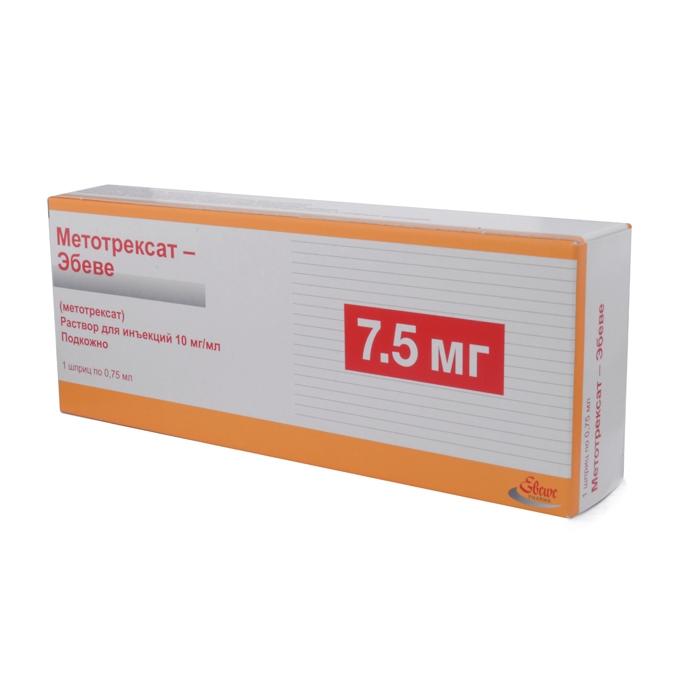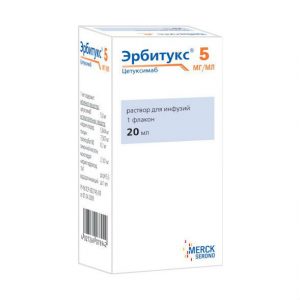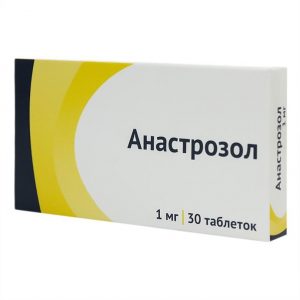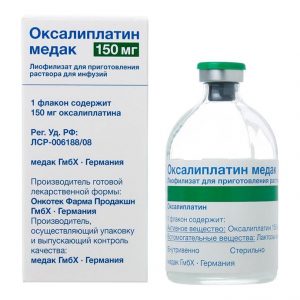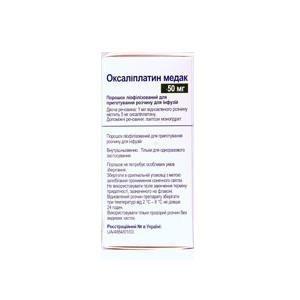Description
Latin name
METHOTREXAT-EBEWE
Release form
Methotrexate-Ebeve solution for injection
Packaging
1 syringe per package.
Pharmacological action
Antitumor drug from group aimetabolitov – analogues of folic acid. Along with antitumor, it has an immunosuppressive effect.
Inhibits dihydrofolate reductase, which is involved in the reduction of dihydrofolic acid to tetrahydrofolic acid, a carrier of carbon fragments necessary for the synthesis of purine nucleotides and their derivatives.
Slows down synthesis, DNA repair and cell mitosis (in the synthesis phase). Particularly sensitive to the action of methotrexate are tissues with high cell proliferation: tumor tissue, bone marrow, epithelial cells of the mucous membranes, embryonic cells.
When cell proliferation of malignant tissues is greater than in most normal tissues, methotrexate can cause malignant growth disorders without irreversible damage to normal tissue.
The mechanism of action for rheumatoid arthritis is unknown, perhaps this action is due to the immunosuppressive properties of methotrexate.
In patients with rheumatoid arthritis, the use of methotrexate reduces the symptoms of inflammation (pain, swelling, stiffness), however, there are a limited number of studies with prolonged use of methotrexate (regarding the ability to maintain remission in rheumatoid arthritis).
With psoriasis, the growth rate of keratinocytes in psoriatic plaques increases compared with normal proliferation of skin cells. This difference in cell proliferation is the basis for the use of methotrexate for the treatment of psoriasis.
Pharmacokinetics
Absorption and distribution of
With the intramuscular administration of Cmax methotrexate in plasma is achieved within 30-60 minutes. Leukemic patients are characterized by wide interindividual variability ranging from 1 to 3 hours.
After iv administration, the primary distribution is 0.18 l / kg (18% of body weight). The distribution of the saturation dose is about 0.4-0.8 l / kg (40% -80% of body weight).
Binding to plasma proteins – about 50%, mainly with albumin. Competitive displacement is possible with simultaneous use with sulfanilamides, salicylates, tetracyclines, chloramphenicol, phenytain.
When taken in therapeutic doses, methotrexate does not cross the BBB. A high concentration of methotrexate in the central nervous system can be achieved with intrathecal administration.
Metabolism
Methotrexate undergoes hepatic and intracellular metabolism with the formation of a pharmacologically active polyglutamine form, also inhibiting dihydrofolate reductase and thymidine synthesis. A small amount of polyglutamate methotrexate may remain in the tissues for a long period of time. Preservation and prolongation of the action of the active metabolites of the drug vary depending on the type of cells, tissues and tumors.
Elimination of
The average T1 / 2 values for methotrexate at a dose of less than 30 mg / m2 are 6-7 hours. For patients receiving high doses of methotrexate, T1 / 2 is 8 to 17 hours.
80 to 90% of the dose taken it is excreted unchanged by glomerular filtration and tubular secretion for 24 hours. Not more than 10% or less of the administered dose is excreted with bile, followed by reabsorption in the intestine.
Pharmacokinetics in special clinical cases
In chronic renal failure, both phases of drug elimination can be significantly lengthened.
Impaired renal function, severe ascites or transudate, and the simultaneous use of drugs such as weak organic acids, which also undergo tubular secretion, can significantly increase the concentration of methotrexate in serum. In accordance with the distribution, methotrexate accumulates in the liver, kidneys and spleen in the form of polyglutamates and can linger in these organs for several weeks or months.
Indications
trophoblastic tumors
acute leukemia (lymphoblastic and myeloblastic variants)
neuroleukemia
non-Hodgkin’s lymphoma, including lymphosarcoma
breast cancer, carcinoma of the lung, squamous cell carcinoma, lung carcinoma of the lung, squamous cell carcinoma, carcinoma of the lung, skin cancer kidney cancer, bladder cancer, testicular cancer, ovarian cancer, penile cancer, retinoblastoma,
medulloblastoma osteogenic sarcoma and soft tissue sarcoma
fungal mycosis (advanced stages)
severe forms of psoriasis, psoriatic arthritis, rheumatoid arthritis, dermatomyositis, systemic lupus erythematosus, standard therapy ankylosing spondylitis (not applicable).
Contraindications
Hypersensitivity to methotrexate and / or any other component of the drug.
Severe anemia, leukopenia, neutropenia, thrombocytopenia.
Renal or liver failure.
Pregnancy and lactation.
Caution: for ascites, effusions in the pleural cavity, gastric and duodenal ulcer, ulcerative colitis, dehydration, gout or nephrolithiasis in the anamnesis, previous radiation therapy or chemotherapy, infectious diseases of a viral, fungal or bacterial nature.
Use during pregnancy and lactation
Taking methotrexate during pregnancy can cause serious fetal malformations (a 14-fold increase in the incidence of malformations of the skull, cardiovascular system and limbs), therefore Methotrexate-Ebeve is contraindicated during pregnancy.
If pregnancy occurs during treatment with methotrexate, consult a specialist regarding the risk of adverse effects of methotrexate on the fetus.
Patients of reproductive age (both women and men) should use effective contraceptives during and for at least 6 months after the end of treatment with Methotrexate-Ebeve.
Methotrexate passes into breast milk in concentrations that are harmful to the baby. Therefore, during the treatment with methotrexate, breastfeeding must be stopped.
Dosage and administration of
methotrexate is part of many chemotherapeutic treatment regimens, and therefore, when choosing a route of administration, regimen and doses in each individual case, one should be guided by the data of the specialized literature.
Methotrexate for injection can be administered intramuscularly, intravenously, intraarterially or intrathecal.
The use of methotrexate in high doses can be very dangerous, therefore, highly-recognized therapy should be carried out only by experienced chemotherapists who can control the concentration of methotrexate in the blood plasma in stationary conditions under the cover of calcium folin.
During the treatment period once a week, it is necessary to examine the blood picture.
Side effects of
From the hemopoietic organs: leukopenia, neutropenia, lymphopenia (especially T-lymphocytes), thrombocytopenia, anemia.
From the digestive system: anorexia, nausea, vomiting, stomatitis, gingivitis, glossitis, pharyngitis, rarely – enteritis, diarrhea, erosive and ulcerative lesions and bleeding from the gastrointestinal tract, in some cases (with prolonged daily use) – dysfunction liver, increased activity of liver transaminases, periportal fibrosis and cirrhosis, liver necrosis, fatty liver, pancreatitis.
From the nervous system: encephalopathy, especially with the introduction of multiple doses intrathecal, as well as in patients who received radiation therapy to the skull. There are also reports of fatigue, weakness, confusion, ataxia, tremors, irritability, cramps and coma. Acute side effects caused by intrathecal methotrexate may include dizziness, blurred vision, headache, back pain, stiff neck, cramps, paralysis, hemiparesis.
From the respiratory system: rarely – interstitial pneumonitis, pulmonary fibrosis, exacerbation of pulmonary infections.
From the urinary system: cystitis, nephropathy, impaired renal function (increased creatinine, hematuria).
From the reproductive system: violation of the process of oogenesis, spermatogenesis, decreased libido / impotence, a change in fertility, teratogenic effects.
On the part of the skin and skin appendages: skin erythema and / or rash, pruritus, urticaria, telangiectasia, furunculosis, depigmentation or hyperpigmentation, acne, peeling of the skin, folliculitis, alopecia (rarely), increased photosensitivity, exacerbation of radiation dermatitis.
On the part of the sensory organs: conjunctivitis, excessive lacrimation, cataracts, photophobia, cortical blindness (at high doses), visual impairment.
Allergic reactions: fever, chills, rash, urticaria, anaphylaxis, malignant exudative erythema (Stevens-Johnson syndrome), toxic epidermal necrolysis (Lyell’s syndrome).
Other: immunosuppression (decreased resistance to infectious diseases), malaise, osteoporosis, hyperuricemia, vasculitis, arthralgia / myalgia.
Drug Interaction
Concomitant use of high doses of Methotrexate with various non-steroidal anti-inflammatory drugs (NSAIDs), including aspirin and other salicylates, azaprop diclofenac, indomethacin and ketoprofen, the toxicity of methotrexate may increase, and in some cases severe toxicity may occur, sometimes even with lethal outcome. With special precautions and appropriate monitoring, the use of methotrexate in low doses (7.5-15 mg per week), in particular in the treatment of rheumatoid arthritis, is not contraindicated in the combination of SNPVP.
simultaneous yspolzovanye sulfanylamydov, proyzvodn h sulfonylmochevyn , fenytoyna, fenylbutazona, amynobenzoynoy acid, probenytsyda, pyrymetamyna or trymetopryma, ryada antybyotykov (penicillin, tetratsyklyn, hloramfenykol), and lipid-lowering antykoahulyantov preparatov (holestyramyn) uvelychyvaet metotreksata risk of toxicity.
Patients receiving concomitant therapy with etretin or other retinoids, should be kept under constant observation because of the increased risk of hepatotoxicity.
Multivitamin preparations containing folic acid or its derivatives may reduce the effectiveness of methotrexate therapy.
L-Aspariganase is a methotrexate antagonist.
Anesthesia with the use of nitrous oxide can lead to the development of unpredictable severe myelosuppression and stomatitis.
Prescribing amiodarone to patients receiving methotrexate therapy for psoriasis can cause skin ulceration.
Several patients with psoriasis or mushroom mycosis who received treatment with methotrexate in combination with PUVA-therapy (methoxal and ultraviolet radiation) had skin cancer.
Caution should be exercised when administering erythrocyte mass and methotrexate simultaneously.
Methotrexate is an immunosuppressant and may reduce the immunological response to vaccination if it is given concomitantly with methotrexate therapy. With simultaneous Introduction with living vaktsynoy mogut razvytsya Heavy antyhenn e reaktsyy
Overdose
Symptoms: Symptoms associated mainly with hematopoietic depression are observed.
Treatment: Calcium folinate is a specific antidote for methotrexate. It counteracts adverse toxic effects.
In case of accidental overdose, calcium folinate (in / in or in / m) is administered at a dose not later than an hour after the administration of methotrexate, equal to or greater than the dose of methotrexate. The administration of folinate calcium is continued until the concentration of methotrexate in serum is lower than the level of 10-7 mmol / l.
With a significant overdose, hydration and urination of the body (pH over 7) may be required to prevent sedimentation of methotrexate and / or its metabolites in the renal tubules. Hemodialysis and peritoneal dialysis do not improve methotrexate elimination. Intermittent hemodialysis with high-flux dialyzers enables effective methotrexate clearance.
In case of overdose with intrathecal administration, repeated lumbar punctures should be performed immediately to ensure rapid drainage of cerebrospinal fluid, neurosurgical intervention with ventriculolumbar perfusion is possible. All of these procedures should be performed against the background of intensive supportive care and systemic administration of high doses of folinate calcium.
Storage conditions
Store out of the reach of children at a temperature not exceeding 10 ° C. Protect from light.
Expiration
See. on the packaging.
Deystvuyuschee substances
Methotrexate
Conditions of supply of
Pharmacy Prescription
dosage form
Dosage
form injection solution
